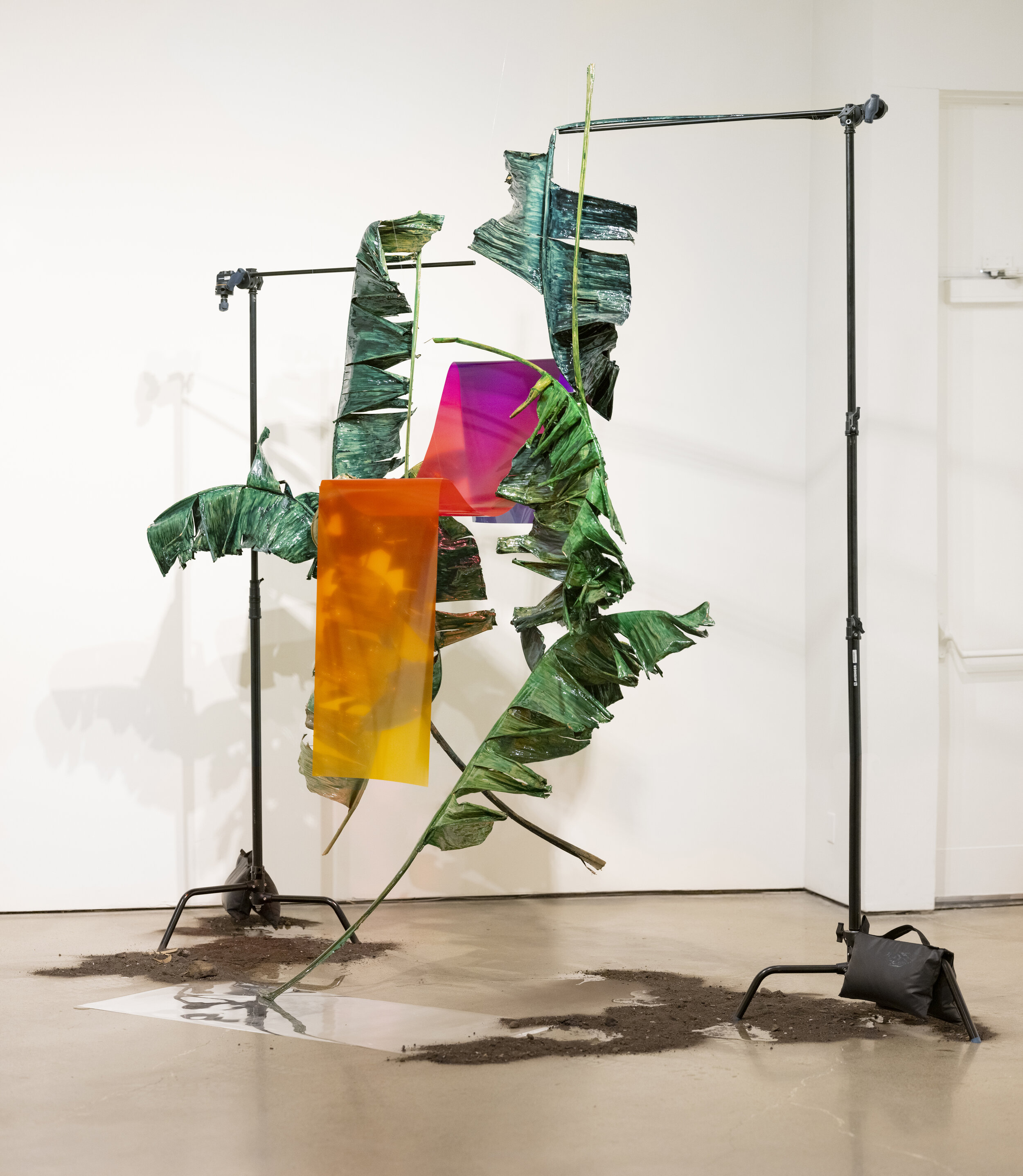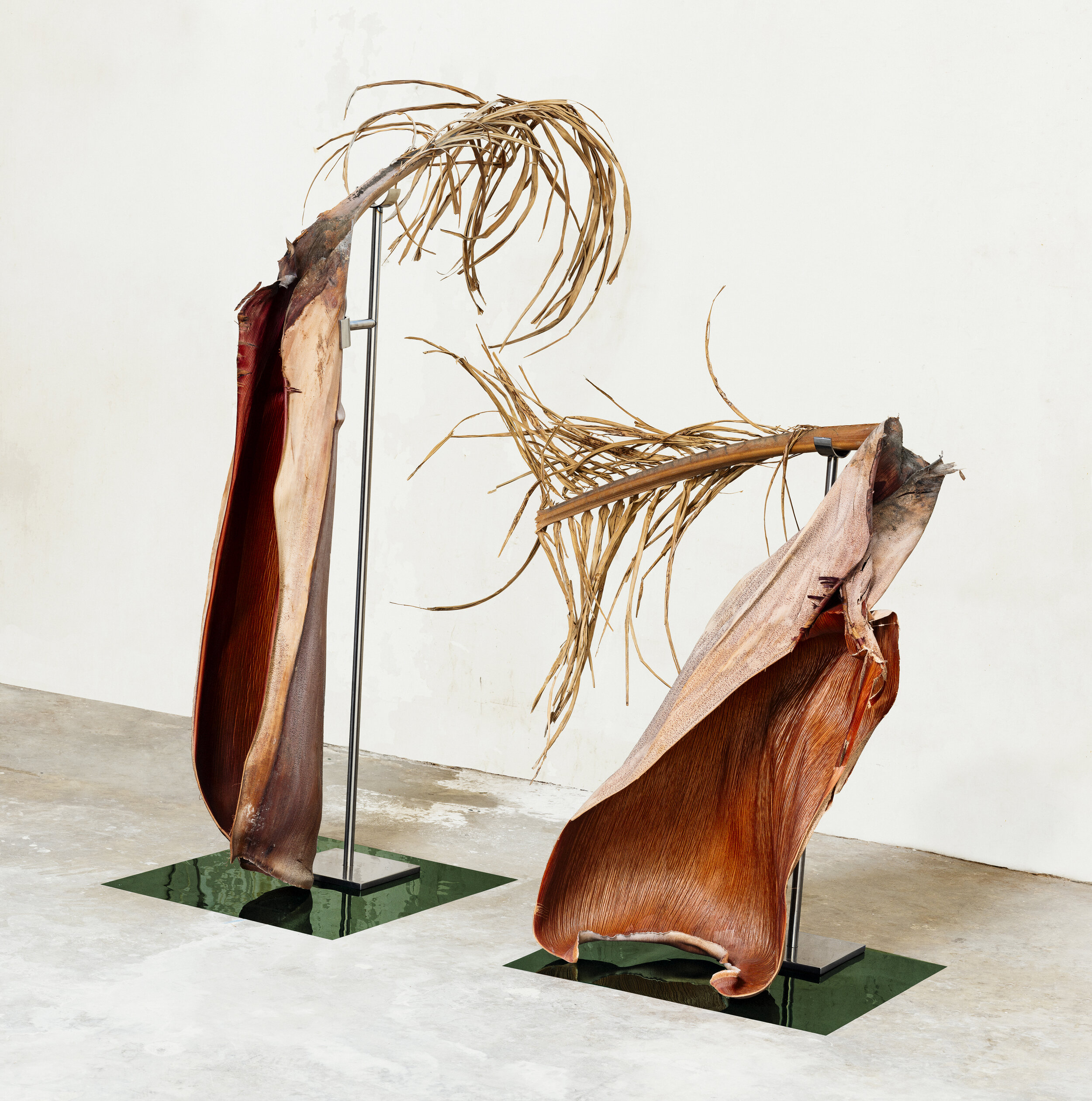Christine Atkinson

“In the piece ‘Remnant’, which is wildfire debris encased in an epoxy, there is a connection between death, fire and plastic, but also it is a kind of fossil of the event, one desciptive of the age that we live in, encased in plastic.”
Interview by: Isabel Sachs
You studied and lived in both Chicago and Santa Barbara, which are very different places, especially climate and light-wise. Does your place of work ever influence your practice? If so, in what way?
My time in Chicago was the first time I lived outside of California. When I came back and moved to Los Angeles, I realized how important California was to my work. I really grew and began to understand what my practice was and what kind of questions I wanted to ask.
The climate and the ecology of Southern California has now become the main focus of my work. It started with identifying the long-standing desire to turn California green – not green as in eco friendly – but literally green. Historian Jared Farmer writes how, to the colonists, the landscape looked deforested and unfinished. They sought to change the landscape, to “emparadise” it, to mold it to something that was easier for them to understand. The native flora is rarely a lush vibrant green. Instead it is silvery, dark, and with rough or often hairy leaves, all adaptations for the hot dry summers. Some plants go completely summer dormant and only come back to life with the first rains in late fall. There’s a cultural expectation that a landscape should look a certain way, and sage scrub and chaparral really subvert those expectations. California has about 6,000 native species of plants, a third of which are endemic. It really is paradise, but we have created this pseudo-paradise over top of it. Deconstructing that has become a huge part of my work.
Your work focuses on colour and you use a variety of mediums to fully explore it, from prints to sculptures. What has been the most challenging material / method to find the ultimate outcome?
I choose the materials based on how they embody color, how they are going to reflect and internalize it, and then send it to the receiver. I tend to let the material dictate how it wants to move, and where it wants to settle. I often find that if the end result was what I had envisioned, the piece was somehow lacking, I didn’t learn anything, there was no moment of discovery. If the question I was asking had such a direct answer, then it must not be the correct question.
Conceptually, epoxy has been the most difficult. It is such a useful and adaptable material and yet in itself is so problematic, both because it’s a challenging material to work with and also because there are obviously environmental concerns around plastic. I think that nature complicates the work: it won’t let you forget that we are living in a world of plastic, that as seductive as it can be, it is it is a sterile dead thing. In the piece “Remnant,” which is wildfire debris encased in an epoxy, there is a connection between death, fire and plastic, but also it is a kind of fossil of the event, one desciptive of the age that we live in, encased in plastic.
Of Paradise, Irvine Art Center
Of Paradise II (LosAngeles), 2019
Of Paradise II (LosAngeles), 2019 (detail)
Still thinking about technique, would you be able to elaborate on the process to create the Spectral Fold?
The question of where color is located is one that I have been thinking about for a long time. We can think of color as a three-pronged interaction: there is the object, the light that touches the object and activates it, and the receiver who interprets the energy into a color. If one of these things is missing we don’t really have “color” as we understand it; we have the potentiality for color, but not color itself. Which raises the question, “Is there color in a perfectly dark room?”
Magenta, I think, is a great entry point into this conversation. It is an extra spectral color, meaning that it is not a part of the visual spectrum, does not have a dedicated wavelength, and is instead a combination of colors that lacks green. Magenta was invented only a few years after the first synthetic pigment, Perkins Mauve, and was one of the vibrant new waves of coal tar synthetic pigments that have colored our world. Magenta inhabits this space between red and blue, and so it’s where we connect these two disparate ends of the spectrum into our color wheel. It represents this space that we have created, but maybe is only real to us? So in the end I wanted to understand this interaction through a fold and not a circle. A fold is such a powerful thing, and these two colors are connected but go off in different directions.
What are your thoughts on the blackest black ever created? Are you ever tempted to create your own unique colour in that sense?
Black is such a fascinating space; it can represent a total void or a complete collection of energy. Vanta black confuses our understanding of that: it takes and absorbs so much that it looks as if nothing is there. MIT just revealed a black that absorbs ten percent more light than Vanta Black. The artist Diemut Strebe coated a diamond with it.
I have never been tempted to make my own color, maybe because I think of color more as a phenomenon or something that happens in a particular moment. But I do want to hoard any perfect color relationships that I find. I think that is what is so alluring about a spectrum, that you have all these in between colors. I get lost looking at the gradations and trying to find where one color becomes another. Unfortunately, I don’t think that kind of color relationship is trademarkable.
King Palm Totems, 2019
Green Of Desire, 2019
Green Of Desire, 2019 (detail)
Remenant, La Tuna Canony, Install 2018
Remenant, 2018
Remenant, 2018
I love the installation shots of "Of Paradise". If you could choose any place to exhibit your works, where would it be?
I would love to install “Of Paradise” and the other pieces in that series “Of Paradise (Los Angeles) II” and the “King Palm Totems” in a space with native ecosystem. In a recent review for Hyperallergic, writer and artist Rosa Boshier refers to California as “in many ways a monstrosity of utopian thinking”. It was done with the best of intentions, but we have inherited a broken and confused landscape filled with eucalyptus, palms, birds of paradise, pepper trees, all of which have become more symbolic of California than anything in the pre-columbian ecosystems. While I am installing something on a more truncated level next fall, it would be ideal to move from the plastic aesthetic of the palms and birds of paradise to a full a mature native landscape. I think that it would help tell the story of Southern California, presenting what the landscape has been shaped into and what it was.
What artwork have you seen recently that has resonated with you?
I just saw a live performance of Bow Hard at the Frog by cellist Fred Lonberg-Holm and sound artist Gustavo Matamoros. The way that the cello and the recordings were in conversation with each other was so moving. Matamoros’ recordings of the Everglades really connected with me. These are the sounds of frogs and birds that, living in the west, I am never likely to encounter in a meaningful way. It brought home how beautiful and vast the world is and yet we are still losing so much of it, that we are on the precipice of the world being silent, or maybe all sounding the same, which is just a different kind of silence.
Untitled (Tropical) II, 2017
Weather System (Carbon Dioxide)
Untitled (Tropical), 2017
How do you go about naming your work?
The names come up while I am making the work. Especially with photography, the title is a chance to give some information about what is present in the image. That is always the difficulty with photography: the materials are important and they often are absorbed by the photograph. The title then becomes the only really permanent option to give the materials back some of their agency.
Is there anything new and exciting in the pipeline you would like to tell us about?
I am working on a small book that will accompany a show that opens next year. It will talk about the notable trees in Los Angeles County, have a guide to places that have native gardens or open spaces where one can easily experience different plant communities. I am excited to compile all this research that I have been collecting in a helpful form.
All images are courtesy of the artist
Publish date: 24/10/19




